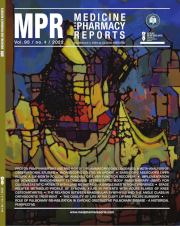Modern imaging techniques in the monitoring of patients with multiple myeloma
DOI:
https://doi.org/10.15386/mpr-2215Keywords:
multiple myeloma (MM), skeletal survey (SS), magnetic resonance imaging (MRI), 18F-fluorodeoxyglucose positron emission tomography-computed tomography (FDG-PET/CT), whole-body low-dose computed tomography (WBLDCT)Abstract
Bone disease for many patients is a serious problem, often causing pathological bone fractures; a spinal collapse, in conclusion, is a disease that affects the quality of life. It is the most frequent feature of multiple myeloma (MM), and it is used to put a diagnostic and the need to start treatment. Because of these complications, imaging plays a vital role in the diagnosis and workup of myeloma patients.
For many years, the conventional radiography has long been considered the gold standard for detecting bone lesions. The main reasons are the wide availability, the low cost, the relatively low radiation dose, and the ability of this imaging method to cover the entire bone system. Because of its incapacity to evaluate the response therapy, more sophisticated techniques such as whole-body low-dose computed tomography (WBLDCT), whole-body magnetic resonance imaging, and 18F-fluorodeoxyglucose–positron emission tomography/computed tomography (PET/CT). In this review, some of the advantages, indications of use, and applications of the three techniques in managing patients with MM will be discussed. The European Myeloma Network guidelines have recommended WBLDCT as the imaging modality of choice for the initial assessment of MM-related lytic bone lesions. Magnetic resonance imaging is the gold-standard imaging modality for the detection of bone marrow involvement. One of the modern imaging methods and PET/CT can provide valuable prognostic data and is the preferred technique for assessing response to therapy.
Downloads
Published
How to Cite
Issue
Section
License
The authors are required to transfer the copyright of the published paper to the journal. This is done by agreeing to sign the Copyright Assignment Form. Whenever the case, authors are also required to send permissions to reproduce material (such as illustrations) from the copyright holder.

The papers published in the journal are licensed under a Creative Commons Attribution-NonCommercial-NoDerivatives 4.0 International License.

